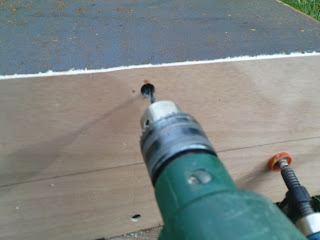Ster wycinamy ze sklejki o grubości 40 mm. Nie musimy kupować tak grubej sklejki, możemy skleić np. 4 warstwy sklejki 10 mm. Zaczynamy od wycięcia jego kształtu. Okrągłe podcięcie w miejscu poszerzenia płetwy służy temu by uniknąć zjawiska karbu i nadmiernie nie koncentrować naprężeń w okolicy dolnego zawiasu. Po wycięciu kształtu profilujemy strugiem i szlifierką dolną część steru. Wyprofilowany ster wzmacniamy obustronnie pasem tkaniny szklanej 600 G/m2. Do laminowania używamy żywicy epoksydowej. Następnie laminujemy całą zanurzoną część płetwy do linii L. Podobnie jak w przypadku kadłuba jeżeli ster był wykonany ze sklejki mahoniowej, sosnowej lub innej o podobnej wytrzymałości to płetwę laminujemy jedną warstwą tkaniny szklanej 200 G/m2. Jeżeli ster był wykonany ze sklejki okume to laminujemy dwiema warstwami tkaniny 600 G/m2. Nie laminujemy steru powyżej linii L. Teraz możemy ster poszpachlować używając żywicy epoksydowej zagęszczonej mikrobalonami. Taką lekką szpachlówką wypełniamy również okrągłe podcięcie. Szlifujemy całość. Część steru powyżej linii L zabezpieczamy głęboko penetrującym lakierem epoksydowym. Następnie malujemy cały ster lakierem poliuretanowym z filtrem UV. Ścianki wszystkich otworów które wywiercimy w sterze nasączamy kilkakrotnie głeboko penetrującym lakierem epoksydowym. Zawiasy przykręcamy na szczeliwo elastyczne (np. sikaflex 291). Ster po zamontowaniu powinien się poruszać bardzo lekko. Jeżeli nie udało się precyzyjnie przykręcić zawiasów to można zmniejszyć (nawet o 1 mm) średnicę sworzni zawiasów steru.
The rudder is cut out of plywood 40 mm thick. We do not have to buy such a thick plywood, we can glue, for example, 4 layers of 10 mm plywood. We start by cutting out its shape. The circular undercut in the area of the fin widening serves to avoid the notch phenomenon and not to concentrate the stress excessively in the area of the lower hinge. After cutting the shape, we profile the lower part of the rudder with a plane and grinder. The profiled rudder is reinforced on both sides with a 600 G / m2 glass fabric belt. We use epoxy resin for laminating. Then we laminate the entire submerged part of the fin to the L line. As in the case of the hull, if the rudder was made of mahogany, pine or other plywood of similar strength, we laminate the fin with one layer of 200 G / m2 glass fabric. If the rudder was made of okume plywood, we laminate with two layers of 600 G / m2 fabric. We do not laminate the rudder above the L line. Now we can smoothen the rudder using epoxy resin thickened with microballoons. We also use this light putty to fill the round undercut. We sanding the whole rudder. The part of the rudder above the L-line should be painted with deep penetrating epoxy paint. Then we paint the entire rudder with polyurethane varnish with a UV filter. The walls of all holes that we drill in the rudder are soaked several times with deeply penetrating epoxy varnish. Screw the hinges onto the flexible sealant (e.g. sikaflex 291). After assembly, the rudder should move very easily. If it is not possible to precisely screw the hinges, the diameter of the rudder hinge pins can be reduced (even by 1 mm).







































